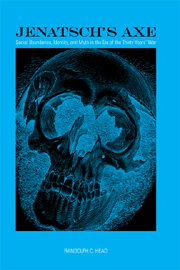Book contents
- Frontmatter
- Contents
- List of Illustrations
- Acknowledgments
- Prologue: Murder (Victim) in the Cathedral
- Introduction
- Chapter 1 A Brief Life of George Jenatsch
- Chapter 2 “Georgius Jenatius, Engadino-Rhetus”: Mapping Identity among Region, Nation, and Language
- Chapter 3 From Religious Zealot to Convert
- Chapter 4 “Something That Every Goatherd Can Do”: Pastor, Soldier, and Noble
- Chapter 5 Hidden Boundaries?: Behind Conventional Views of Jenatsch
- Chapter 6 Jenatsch after 1639: Storytelling in Biography and Myth
- Epilogue: The Past, the Present, and Magic Bells
- Notes
- Bibliography
- Index
Epilogue: The Past, the Present, and Magic Bells
Published online by Cambridge University Press: 05 February 2013
- Frontmatter
- Contents
- List of Illustrations
- Acknowledgments
- Prologue: Murder (Victim) in the Cathedral
- Introduction
- Chapter 1 A Brief Life of George Jenatsch
- Chapter 2 “Georgius Jenatius, Engadino-Rhetus”: Mapping Identity among Region, Nation, and Language
- Chapter 3 From Religious Zealot to Convert
- Chapter 4 “Something That Every Goatherd Can Do”: Pastor, Soldier, and Noble
- Chapter 5 Hidden Boundaries?: Behind Conventional Views of Jenatsch
- Chapter 6 Jenatsch after 1639: Storytelling in Biography and Myth
- Epilogue: The Past, the Present, and Magic Bells
- Notes
- Bibliography
- Index
Summary
George Jenatsch's remains are buried again—probably. After 1959, the contents of his grave in the Chur cathedral floor, including the damaged skull that archaeologist Erik Hug removed, received careful study for several years. The Swiss National Historical Museum restored the luxurious clothing Jenatsch died in and identified the various objects in his grave. In 1972, the clothing and objects (but not his bones) went on display in a glass case as part of the treasures of the Chur cathedral. Some scientific examination of the bones took place between 1959 and 1961, including a dental examination, before Hug apparently took them to his private residence in Zurich. After that, however, their fate becomes uncertain. According to the cantonal archaeological service of Graubünden, “regarding the bones we must consider it very likely that in 1961 they found their way back into the grave, including the skull.” Hug definitely kept several pieces of trim from Jenatsch's clothing, and a former colleague later suggested that he kept some small pieces of bone for further research, though this cannot be confirmed. If so, they are probably lost, as are all of Hug's notes from the excavation. In fact, even the exact location in the cathedral where Jenatsch's body was found, and perhaps returned, is once again unknown, according to the archaeological service. Meanwhile, stories about his bones' fate circulate among historians interested in Jenatsch, including one that Jenatsch's bones only returned to Chur after the canton sent a uniformed policeman to retrieve them from Hug, who never had permission to remove them in the first place.
- Type
- Chapter
- Information
- Jenatsch's AxeSocial Boundaries, Identity, and Myth in the Era of the Thirty Years' War, pp. 133 - 136Publisher: Boydell & BrewerPrint publication year: 2008



